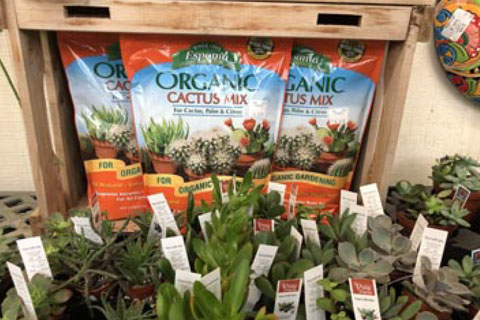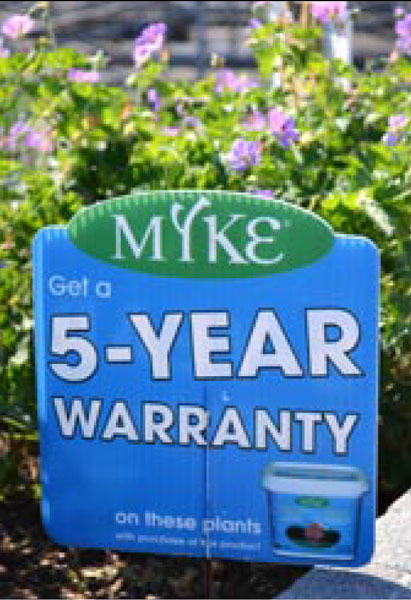4/1/2020
Feed the Need for Fertilizer
Bill Calkins

When gardeners begin feeding their plants, they’re often amazed with the results. For many of us in the industry it seems like a no-brainer, but hearing stories in person and on social media, a knowledge gap is evident. It wouldn’t be an understatement to claim that one out of four casual gardeners don’t actually feed their plants. In this challenge lies a lot of opportunity—both in terms of increasing knowledge and boosting sales.
Pictured: Here’s one example from Gale’s Garden Center in Westlake, Ohio, where the cactus and succulent food is cross-merchandised with the succulents.
So the questions is: How can garden centers increase the likelihood of shoppers adding plant food to their carts each time they buy plants? Unfortunately, there’s not a simple answer, but often good retail strategies can be implemented to increase the chance customers will opt for some fertilizer with their beautiful blooms. Here are a few ways that can increase your chance for success.
Subtle (and not-so-subtle) Reminders
More often than not, your plant food and plant care products are located away from your plant displays. Perhaps this is because you don’t want packaging to get wet and fade in a greenhouse. Or maybe you prefer to keep plant care products merchandised in a concise location to make counting inventory easier and restocking more efficient.
Consider this from a novice gardener’s perspective: out of sight, out of mind. Just selecting plants can be a challenge for many and then add on the need to remember fertilizer. It’s not hard to guess what will happen. The cart will be full of plants and that customer will make a beeline for the register. Consider adding signage throughout plant displays recommending plant food and directing buyers to the shelves of fertilizers. Step up your game by including images of the appropriate products: annuals food for annuals, rose food for roses, shrub fertilizers for shrubs and so on. You get the idea.
Garden center guru and consultant for The Garden Center Group and Horticultural Advantage, Sid Raisch, believes the key is to market constantly throughout the store.
“Use empty packages with signage, then close with a big display at the register,” he suggests. “I call this the ‘batteries in Walmart’ strategy because that’s what’s resulted in a box or drawer full of batteries in every house.”
All of your employees are seen as experts in the eyes of your customers, so remind them during staff meetings to recommend fertilizer to all shoppers. Educate your team on the benefits of feeding plants and arm them with bits of information about how plant food can increase growth and keep blooms bright and healthy. Sometimes a quick reminder can be all it takes to spur an add-on sale. Take it up a notch by getting buttons to add to aprons and shirts asking, “Did you remember plant food?” for a visual cue. Set sales goals to help reinforce the need to speak with customers about the products.
Speaking of your staff, how about keeping a small display of plant food right by the registers? If your cashiers ask each shopper checking out if they remembered plant food with a quick tip about feeding, you could see a tremendous uptick in fertilizer sales. This is an easy way to offer a last bit of advice before customers head out the door.
And if all else fails, just put the plant food in their cart. No doubt, some of you have done this in the past. Clayton Bieberfeld at County Line Nursery in Harleysville, Pennsylvania, certainly has.
“A lot of the time I say they’ll need to have it, as I’m putting it in their cart,” he says. “Or I might ask if they still have some of an exact type of fertilizer left and if they need more.”
This way, they must answer about this exact product. When they say they don’t, you’re set up to sell it more easily. It’s all about reading a customer, he adds.
Cross-Merchandising
Consider placing small displays of plant food on benches of high-turn products. You don’t need to include the entire fertilizer display, but just a handful of plant food products throughout popular areas or categories will inspire shoppers to either grab a container or venture off in search of the plant care department. Remember to restock these mini displays each morning to keep them filled and tidy for the day ahead.
Plant food can be merchandised with just about every category of pants, from annuals and perennials to vegetables and indoor plants. If you carry products specific to these crops, try to keep them near the displays. If a general plant food is appropriate, offer a couple different sizes to meet shopper needs. No one probably needs a 25 lb. bag of plant food, but customers buying 10 one-gallon perennials or five shrubs for a garden will need more than a small container of fertilizer, so making various sizes of containers available will be sure to cover all bases.
One place it seems like plant food is often cross-merchandised is specialty plants. Very rarely are orchids seen displayed without orchid food and the same can be said for roses. Why not take the same approach for other crops like annuals, perennials, vegetables and shrubs? If your customers become used to seeing the appropriate plant food offered with all plant categories, they’ll be much more likely to grab some when choosing their plants.
 Pictured: Some manufacturers, like the makers of Myke—a natural growth enhancer with mycorrhizae—offer their own warranty with some conditions.
Pictured: Some manufacturers, like the makers of Myke—a natural growth enhancer with mycorrhizae—offer their own warranty with some conditions.
Take a lesson from the cut flower industry. When you buy a bunch of cut flowers from just about any store, there’s a little packet of plant food attached. That removes any guesswork from the equation. Many fertilizers are available in small quantities and even if you don’t attach one to each hanging basket, there’s probably an opportunity to hang a strip of small fertilizer packages from a hook near the basket display or at the end of each row. Give it a try and you might be pleasantly surprised how many people toss them into the cart.
Guarantee It
Sid feels a good approach is to choose one fertilizer (and one soil) and market it throughout the store as a “Planting Success Assurance.” He sees stores calling this insurance, a guarantee or a warranty, but reminds retailers this is a regulated industry (warranties) and advises garden centers to distance themselves from this kind of wording.
Another way to use plant food to reassure customers is by doubling your plant warranty when the appropriate soil and fertilizer is used, for example from one year to two years, or even three, Sid says. “The claims or returns are, by math, not really much of a factor and can be as little as 1%.”
Keep Calm and Feed Your Plants
We all know an educated customer not only buys more, but also becomes more likely to come back season after season. Helping your customers achieve success by demystifying the process of feeding their plants has so many benefits for your business, from increased sales to increased loyalty.
When putting together your plan of attack for 2020, consider implementing one or more of the plant food strategies in this article. Help your staff understand how it will improve success and impact your bottom line. One final idea is to start an internal contest and recognize team members who add the most plant food units to carts and use this to build sales. Everyone likes a bit of competition, right?
Sell Healthier Plants
When talking to Sid Raisch about the topic of cross-selling plant food, he brought up a good point.
“A question to ask is whether just offering fertilizer (in the N-P-K sense) is enough,” he mused. “Plants need microorganisms, mycorrhizae and micronutrients more than the short-term ‘cheap thrill’ of standard fertilizer.”
This is an excellent reminder and one that’s being addressed more and more these days with new products coming to market.
Green Profit reached out to the experts at Mycorrhizal Applications to weigh in. Here’s what Sales and Commercial Marketing Manager Blair Busenbark had to say:
Each spring, garden centers purchase a collection of bareroot plants to sell. Often, these plants arrive at the very beginning of what retailers hope will eventually become spring. The collection of plants often includes fruit trees, roses, small fruits and perennials. One of the biggest problems with bareroot plants is that if they are not quickly sold, they often deteriorate in quality and need to be sold off at a discounted price. Rather than sell them as is, it might make more sense to transition the plants into a higher value product offering. With the purchase of some nursery containers, fertilizer and a growing mix, these bareroot plants can be planted into the containers and transformed into an offering sold at a premium price. But what is often missing in this process is the addition of mycorrhizae.
The addition of mycorrhizae helps these bareroot transplants expand their root mass and improve their uptake of water and nutrients. And what this means at retail is these bareroot plants will more quickly transition into growing leafed-out plants that sell more quickly.
The mycorrhizae can be added into the soil or applied as a drench. Whatever option you choose, this small additional cost will make a big difference in your retail success. On top of that, for retailers that sell their plants with a guarantee, this simple step will ensure these newly created premium plants will go into the garden or landscape and succeed, with fewer returns. GP